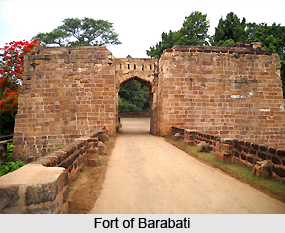 History of Puri District, Odisha asserts the development and growth of this region ever since pre-historic times, continuing through the medieval period and also traces the nomenclature of this Indian district. Various kinds of stone tools derived from Puri District suggest about the ancient pre-historic life existent in this portion of the country. Stone tools have been discovered from numerous areas which include Sundargarh, Mayurbhanj, Keonjhar and Dhenkanal, which have yielded formations of `murrams`, river gravels, secondary laterite pits and so on.
History of Puri District, Odisha asserts the development and growth of this region ever since pre-historic times, continuing through the medieval period and also traces the nomenclature of this Indian district. Various kinds of stone tools derived from Puri District suggest about the ancient pre-historic life existent in this portion of the country. Stone tools have been discovered from numerous areas which include Sundargarh, Mayurbhanj, Keonjhar and Dhenkanal, which have yielded formations of `murrams`, river gravels, secondary laterite pits and so on.
Etymology of Puri District
The headquarters town of Puri has inspired the nomenclature of the district `Puri`. The Chinese traveller Hieun Tsang had claimed that the old name of this place was `Charitra`, which he had referred to as `Che-li-ta-lo`. This particular fact had also been mentioned by Cunningham.
Medieval History of Puri District
Following the erection of the temple of Jagannath at Puri District, the significance of Puri as a crucial centre of Vaishnavism was enhanced, particularly after the establishment of the deities of Lord Jagannath, Devi Subhadra and Lord Balabhadra. Soon afterwards, Puri became renowned as the `Purusottama Kshetra`. The `Nagari` plate of Anangabhima III belonging to Saka year 1151 to 1152 or 1229 to 1230 A.D, reveals that this area was termed as the Purusottama Kshetra.
The Marathas, Mughals and also the early British governors used the word `Purusottama Chhatar` while mentioning Puri. Kalika Purana and `Yogini Tantra` both have suggested that the district was called Purusottam, though this region was also referred to as `Utkal`. Sometimes, Purusottama Kshetra was also known as `Purusottama Puri` or shortened into `Chhatra` or `Kshetra`. Certain British records have indicated that Puri District was also termed as `Pooree` but currently, the name Puri is the most popular.
Odisha was subdivided into three `circars` under the Mughal regime (1592 to 1751) which was titled as `Kataka`, `Jaleshwar` and `Bhadraka`. Each of the circars was further classified into `Bishis` and Kataka circar`s portion was Puri District. Certain transformations were introduced by the Marathas in Puri, after they conquered this region during 1751.
Modern History of Puri District
Thereafter, Odisha was divided into five `Chalakas` of Balasore, Pipli, Soro and Kataka. Large tracts of land of Puri belonged to Pipli Chalaka. Chalakas were again classified into `Parganas` which were again subdivided into `Taluqs` or `Mahals`. When the British invaded Odisha during 1803, more changes were incorporated in the revenue divisions of Odisha and in 1804 Northern and Southern Divisions were the two final divisions of this province, wherein Mahanadi River acted as the boundary. However within 1805 both divisions were merged together.
The Raja of Khurdha rebelled in 1804 and consequently he was imprisoned at Cuttack, in the Fort of Barabati. He was duly released after his empire was captured and he was allowed to reside in Puri, at Balisahi. During that time he served as the superintendent of the Jagannath Temple at Puri. Till the year 1816, Puri functioned as the capital of Odisha and the official headquarters of the collector. During 1806, the headquarters was proposed to be shifted to Jajpur but it failed to receive the sanction of the Government. The establishment of the collector was then moved to Cuttack during August 1814 which was again changed to Puri in the month of December. Yet again the headquarters was moved to Cuttack during the reign of Marathas and Mughals. Puri was under the jurisdiction of a joint Magistrate which supervised Kiran, Thana of Pipli, Hariharpur and Gop from 1813 to 1819. By the year 1819, Khurdha was entrusted the responsibility of taking care of the above `thanas`. However, Odisha was again divided into two divisions on 11th February, 1822 and the office of the joint magistrate was declared null and void.
Odisha was yet divided into three districts consisting of Jagannath, Balasore and Cuttack during 23td October, 1828 which was later referred to as Puri. H. Ricketts, R. Hunter and W. Wilkinson were the very first magistrate and collectors of the regions of Balasore, Cuttack and Puri respectively. Odisha became an independent province in 1936. Khandapara, Nayagarh, Daspalla and Ranapur were included as portions of Puri District which possessed its headquarters at Puri. Nayagarh, Khurdha, Bhubaneshwar and Puri Sadar were the sub divisions of the old Puri District. Four `tehsils` known as Krushna Prasad, Pipli, Nimapara and Sadar made up the District of Puri.
Puri District was again divided into three different districts by 1995 which included Puri District which comprised Puri Sadar Sub-Division, Khurdha District which comprises Bhubaneshwar and Khurdha Sub-Division and Nayagarh District which comprised Nayagarh Sub-Division.






